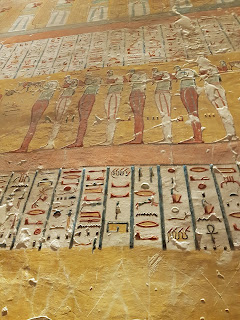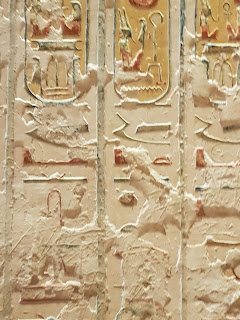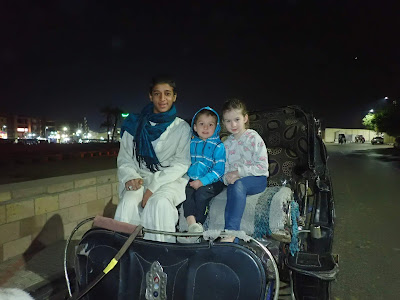Day 4, Valley of the Kings.
According to our tour guide, the Pyramids were simply invitations for grave robbers to come and take what had been prepared for the ancient pharaohs. Thus the move to the Valley of the Kings. Many of these tombs were built not just for the pharaoh but for many of his family members who were never in the position of frank leadership.
Bringing your own camera inside costs an additional $30 per camera so we decided to roll with our cell phones. Above is a plastic model of the canyon with the sites and tomb numbers. Under the model, you can see how deep into the mountain the tombs extend. My cell phone did not capture this very well
If you have questions about the history of the Valley of the Kings, you will need to research it on your own or ask Jari. I spent my time keeping the kids entertained, fed, and quiet while the tour guide gave tidbits of history.
The kids had fun being creative with the small pieces of limestone
We had time to visit 3 different tombs and because I cannot give many details I may just let the pictures speak for themselves.
Depicted on each tomb are stories of accomplishments and more commonly, themes such as the afterlife, the final judgment, and pictures of each pharaoh receiving the Key of Life
The golden arches here are actually the body of Shu, the God of the Sky.
The soft limestone made it easy to work with, but clearly not something that would last forever.
One would think that it would be cooler inside but it was actually much warmer.
I thought this was interesting, a serpent with wings and legs
A few of them had sarcophagi to see.
Looking at areas that are not kept up or were never cleaned up
Even though crocodiles were very common along the Nile, they don't make their appearance as often as you would think on these hieroglyphics.
Sobek was the God of the Nile and was responsible for controlling the water and the marshes.
Ammut was known as the "Eater of Hearts" wherein the afterlife, if your heart was weighed during the judgment and found to be heavy, would eat your heart and block your way/stop you from reaching the afterlife.
In other stories, some pharaohs would depict their foe as a crocodile to shame them rather than give them human form.
Here is the pharaoh presenting a gift to one of the gods.
Same thing here, pharaoh presenting a gift to the high god Amun-Ra
Quick family photo on a timer
Not all the tombs are open all the time. Each season or year to open 10 or so which means if you come back, you could see different tombs.
This tomb was covered by wood only without a nice entry. We simply stopped to take a shadow photo
Here Charlotte is showing how dirty her shoes became walking on the fine limestone
Hazel wanted in. This was after the very expensive novelty ice creams which the kids loved. Zach was happy to munch of Ketchup flavored potato chips...
We then made a stop at a factory of stone carvers. Apparently, these people used to live up against the mountains and when the Egyptian Government wanted their lands, they claimed to be the descendants of those who originally carved the tombs for the Kings many millennia ago and wanted a lot of money for moving their homes/city across the road. Turns out, after genetic testing, it seems they were correct. Today, as part of the deal the Egyptian government gave them, they received a certain amount (weight) of limestone and basalt they can use to carve and sell to those visiting.
The next stop was the Mortuary Temple of Hatshepsut, as shown on the ticket. Yes, I was wearing sandals. Yes, my feet got really dirty that day.
Model of the temple
This is the Mortuary Temple at the base of Al-Deir mountain built by and for the 18th Dynasty female Pharoah Hatshepsut who reigned from 1479-1458 B.C. The Valley of the Queens was where the female Pharoah's and Queens of the male Pharoah's and their children are buried. The temple was fully excavated between 1893 and 1906. It is considered one of the greatest architectural achievements of the ancient world.
Hatshepsut built this temple to honor herself and solidify her power and importance.
All the pharaohs had their tombs built during their lifetimes and under their direction. If a tomb was unfinished when the pharaoh died, then work would cease and begin for the succeeding pharaoh.
These pillars are statues of Osiris, the god of fertility, agriculture, the dead, the resurrection, and the afterlife. His legs are wrapped like a mummy. His crown is an Atef - the symbol of Upper and Lower Egypt.
After the temple, we were back on the boat for some unstructured time.
Man, that water was cold...
The last activity was organized by our tour guide - a carriage ride through Luxor at night.
Our driver was actually pretty cool. He left the kids to hold the reins a few times, was really kind, and did not pander for money afterward
We rode through markets
Past the central Mosque
And saw many forms of transportation
This is the Luxor Temple at night
The last stop was a market for some hot chocolate. While the kids sipped on their drinks I went for a quick walk with one of the other American dads through the market which was cool.
Another late night while waiting for dinner.































































































Comments